 IAS on Facebook IAS on Facebook
 IAS on Instagram IAS on Instagram

|

IAS Aroid Quasi Forum
About Aroid-L
This is a continuously updated archive of the Aroid-L mailing list in a forum format - not an actual Forum. If you want to post, you will still need to register for the Aroid-L mailing list and send your postings by e-mail for moderation in the normal way.
|
Philodendron sagittifolium at female anthesis!
|
From: Steve at ExoticRainforest.com (ExoticRainforest) on 2008.06.07 at 03:00:31(17776)

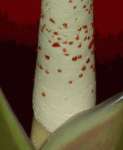
Someone tell me what is happening!
This spathe of Philodendron sagittifolium opened this morning. There is a second right beside it opening tonight. These photos were taken at 9:30PM local time. There is a slight smell of mint to the pheromone and if your hand is in front of the spathe, but not touching, you can feel the thermogenetic heat. The red dots were not there this afternoon, but are clearly visible now. I have no idea what these are! Julius, Leland, Dr. Croat, anyone who knows! What are these, what is the purpose? Obviously no female flowers appear evident yet but I'll likely be up much of the night!
Steve Lucas
| +More |
www.ExoticRainforest.com
-------------- next part --------------
An HTML attachment was scrubbed...
URL: http://www.gizmoworks.com/mailman/private/aroid-l/attachments/20080606/a30a4d0b/attachment-0001.htm
-------------- next part --------------
A non-text attachment was scrubbed...
Name: Philo-sag-spathe-night-1.gif
Type: image/gif
Size: 95657 bytes
Desc: not available
Url : http://www.gizmoworks.com/mailman/private/aroid-l/attachments/20080606/a30a4d0b/attachment-0002.gif
-------------- next part --------------
A non-text attachment was scrubbed...
Name: Philo-sag-spathe-night-2.gif
Type: image/gif
Size: 163017 bytes
Desc: not available
Url : http://www.gizmoworks.com/mailman/private/aroid-l/attachments/20080606/a30a4d0b/attachment-0003.gif
|
|
From: Thomas.Croat at mobot.org (Tom Croat) on 2008.06.07 at 04:20:47(17778)
Steve: I commented on the dots before seeing the pictures. I thought
you were talking about he dots on the petioles. The dots on the spadix
are from an accumulation of resin. The resin gets on the beetles and
makes them sticky so that when they leave they can carry away the pollen
which otherwise won't stick to their bodies.
Tom
| +More | |
________________________________
From: aroid-l-bounces at gizmoworks.com
[mailto:aroid-l-bounces at gizmoworks.com] On Behalf Of ExoticRainforest
Sent: Friday, June 06, 2008 10:01 PM
To: Discussion of aroids
Subject: [Aroid-l] Philodendron sagittifolium at female anthesis!
Someone tell me what is happening!
This spathe of Philodendron sagittifolium opened this morning. There is
a second right beside it opening tonight. These photos were taken at
9:30PM local time. There is a slight smell of mint to the pheromone and
if your hand is in front of the spathe, but not touching, you can feel
the thermogenetic heat. The red dots were not there this afternoon, but
are clearly visible now. I have no idea what these are! Julius,
Leland, Dr. Croat, anyone who knows! What are these, what is the
purpose? Obviously no female flowers appear evident yet but I'll likely
be up much of the night!
Steve Lucas
www.ExoticRainforest.com
-------------- next part --------------
An HTML attachment was scrubbed...
URL: http://www.gizmoworks.com/mailman/private/aroid-l/attachments/20080606/9185ace0/attachment.htm
|
|
From: Steve at ExoticRainforest.com (ExoticRainforest) on 2008.06.07 at 04:26:42(17779)
Just got this from Dr. Croat!
Steve: The dots are glands that produce a nectar that attracts ant guards in the natural state. These ants feed off of the nectar and keep the phytofagus insects at bay. Thus it is a mutualistic association.
Tom
Someone tell me what is happening!
This spathe of Philodendron sagittifolium opened this morning. There is a second right beside it opening tonight. These photos were taken at 9:30PM local time. There is a slight smell of mint to the pheromone and if your hand is in front of the spathe, but not touching, you can feel the thermogenetic heat. The red dots were not there this afternoon, but are clearly visible now. I have no idea what these are! Julius, Leland, Dr. Croat, anyone who knows! What are these, what is the purpose? Obviously no female flowers appear evident yet but I'll likely be up much of the night!
Steve Lucas
| +More | |
www.ExoticRainforest.com
-------------- next part --------------
An HTML attachment was scrubbed...
URL: http://www.gizmoworks.com/mailman/private/aroid-l/attachments/20080606/35321caa/attachment.htm
|
|
From: hermine at endangeredspecies.com (hermine) on 2008.06.07 at 05:05:04(17781)
>The red dots were not there this afternoon, but are clearly visible
>now. I have no idea what these are!
they look like some kinda goopy leaking out. have you tried tasting it?
hermine
| |
|
From: Steve at ExoticRainforest.com (ExoticRainforest) on 2008.06.07 at 05:45:57(17782)

This is the midnight photo. Next one at 1:30AM.
One thing just dawned on me. This morning ants were all over this spathe and spadix! Not a single one can be seen in any of my photos tonight! Wrong ant speies?
Steve
| +More |
-------------- next part --------------
An HTML attachment was scrubbed...
URL: http://www.gizmoworks.com/mailman/private/aroid-l/attachments/20080607/0459bedc/attachment-0001.htm
-------------- next part --------------
A non-text attachment was scrubbed...
Name: P.-saggi.-Midniight.gif
Type: image/gif
Size: 137669 bytes
Desc: not available
Url : http://www.gizmoworks.com/mailman/private/aroid-l/attachments/20080607/0459bedc/attachment-0001.gif
|
|
From: Steve at ExoticRainforest.com (ExoticRainforest) on 2008.06.07 at 05:50:15(17783)
By the way, if you are wondering why these photos are a bit "soft", I'm doing the photography in total darkness with just one small light to help find the focus. Sometimes I can't even find the spathe! The spathe is 8 feet (well over 2.5 meters) away! I can't get any closer because my wheelchair won't float! There is a big pond between me and the spathe! I've got the assist of an infrared focuing device, but those are not totally accurate either!
Steve
| +More | |
This is the midnight photo. Next one at 1:30AM.
One thing just dawned on me. This morning ants were all over this spathe and spadix! Not a single one can be seen in any of my photos tonight! Wrong ant speies?
Steve
-------------- next part --------------
An HTML attachment was scrubbed...
URL: http://www.gizmoworks.com/mailman/private/aroid-l/attachments/20080607/bbec9ff8/attachment-0001.htm
|
|
From: Steve at ExoticRainforest.com (ExoticRainforest) on 2008.06.07 at 06:08:49(17784)
Thanks again!
Steve
| +More |
----- Original Message -----
From: Tom Croat
To: Discussion of aroids
Sent: Friday, June 06, 2008 11:20 PM
Subject: Re: [Aroid-l] Philodendron sagittifolium at female anthesis!
Steve: I commented on the dots before seeing the pictures. I thought you were talking about he dots on the petioles. The dots on the spadix are from an accumulation of resin. The resin gets on the beetles and makes them sticky so that when they leave they can carry away the pollen which otherwise won't stick to their bodies.
Tom
------------------------------------------------------------------------------
From: aroid-l-bounces at gizmoworks.com [mailto:aroid-l-bounces at gizmoworks.com] On Behalf Of ExoticRainforest
Sent: Friday, June 06, 2008 10:01 PM
To: Discussion of aroids
Subject: [Aroid-l] Philodendron sagittifolium at female anthesis!
Someone tell me what is happening!
This spathe of Philodendron sagittifolium opened this morning. There is a second right beside it opening tonight. These photos were taken at 9:30PM local time. There is a slight smell of mint to the pheromone and if your hand is in front of the spathe, but not touching, you can feel the thermogenetic heat. The red dots were not there this afternoon, but are clearly visible now. I have no idea what these are! Julius, Leland, Dr. Croat, anyone who knows! What are these, what is the purpose? Obviously no female flowers appear evident yet but I'll likely be up much of the night!
Steve Lucas
www.ExoticRainforest.com
------------------------------------------------------------------------------
_______________________________________________
Aroid-L mailing list
Aroid-L at www.gizmoworks.com
http://www.gizmoworks.com/mailman/listinfo/aroid-l
-------------- next part --------------
An HTML attachment was scrubbed...
URL: http://www.gizmoworks.com/mailman/private/aroid-l/attachments/20080607/3f0a7f0d/attachment-0001.htm
|
|
From: Steve at ExoticRainforest.com (ExoticRainforest) on 2008.06.07 at 06:42:13(17785)

This is the 1:30AM photo. No significant change so I'm going to try for 4 hours sleep. Next attempt around 5:30 in the morning.
Steve
| +More |
-------------- next part --------------
An HTML attachment was scrubbed...
URL: http://www.gizmoworks.com/mailman/private/aroid-l/attachments/20080607/c94e5cf7/attachment-0001.htm
-------------- next part --------------
A non-text attachment was scrubbed...
Name: P.-saggit-1-30AM.gif
Type: image/gif
Size: 159749 bytes
Desc: not available
Url : http://www.gizmoworks.com/mailman/private/aroid-l/attachments/20080607/c94e5cf7/attachment-0001.gif
|
|
From: Steve at ExoticRainforest.com (ExoticRainforest) on 2008.06.07 at 12:36:15(17787)

OK, now Dr. Croat has explained the red dots are a resin for the pollinating beetle to get on their bodies and thus be able to pick up and carry pollen. During the night the thermogenic heat reduced as did the pheromone. By 1:30AM it was barely detectable.
I forgot that the auto overhead watering system would kick in at 5:30AM! Didn't stay out long at 5:30 in the morning with the rain falling on my head. When that was done around 6:45 I tried to get back to taking photos. By the way, it is pretty much like being in the rain forest in your pajamas!
Once the "rain" stopped this one was taken at 6:30AM. The spadix still appears almost like the 1:30AM shot. I think I notice is the color of red on the spathe itself just beneath the opening to the spadix has reduced in intensity. No female flowers appear present. This is obviously going to be a two day event, perhaps longer, with the species Philodendron sagittifolium. I'll be checking every few hours for activity.
So a couple of observations:
1) the pheromone is not apparent this morning.
2) No thermogenic heat can be detected
3) The red at the lip of the spathe is reduced
4) No female flowers are present
The spathe is obviously waiting on something to continue the cycle of reproduction. I'll guess we'll check every few hours and see what transpires.
Now where did I put my Scarab Beetles?
By the way, Julius, Leland, Marc, Ron, Denis, any of you that know about this activity please teach me!
Steve Lucas @ 7;25AM Maybe 3 hours sleep!
| +More |
www.ExoticRainforest.com
-------------- next part --------------
An HTML attachment was scrubbed...
URL: http://www.gizmoworks.com/mailman/private/aroid-l/attachments/20080607/7094c5dd/attachment-0001.htm
-------------- next part --------------
A non-text attachment was scrubbed...
Name: phil-saggit-6-30-am-2.gif
Type: image/gif
Size: 156737 bytes
Desc: not available
Url : http://www.gizmoworks.com/mailman/private/aroid-l/attachments/20080607/7094c5dd/attachment-0001.gif
|
|
From: Steve at ExoticRainforest.com (ExoticRainforest) on 2008.06.07 at 12:46:57(17788)

One big note: If you are not up to speed on this type of event there are two documents you need to read, both online:
The first is Julius excellent by easy to grasp text on what is happening here:
http://www.exoticrainforest.com/Natural%20and%20artificial%20pollination%20in%20aroids.html
The second is a thread on UBC which has been going on for weeks. It offers an altrnative view as to what "additional" activities that haven't been fully explored may be involved. Since this spathe is not white, it should be less effect as an "infrared dish", but the idea is intriguing.
http://www.ubcbotanicalgarden.org/forums/showthread.php?t8988
Part of it is bogus! I know, because I wrote it! But the basic thread is great food for thought!
Marc Gibernau is beginning to investigate this idea. And Marc will be our guest at the 2008 IAS show! Be there!
Steve Lucas
| +More | |
www.ExoticRainforest.com
OK, now Dr. Croat has explained the red dots are a resin for the pollinating beetle to get on their bodies and thus be able to pick up and carry pollen. During the night the thermogenic heat reduced as did the pheromone. By 1:30AM it was barely detectable.
I forgot that the auto overhead watering system would kick in at 5:30AM! Didn't stay out long at 5:30 in the morning with the rain falling on my head. When that was done around 6:45 I tried to get back to taking photos. By the way, it is pretty much like being in the rain forest in your pajamas!
Once the "rain" stopped this one was taken at 6:30AM. The spadix still appears almost like the 1:30AM shot. I think I notice is the color of red on the spathe itself just beneath the opening to the spadix has reduced in intensity. No female flowers appear present. This is obviously going to be a two day event, perhaps longer, with the species Philodendron sagittifolium. I'll be checking every few hours for activity.
So a couple of observations:
1) the pheromone is not apparent this morning.
2) No thermogenic heat can be detected
3) The red at the lip of the spathe is reduced
4) No female flowers are present
The spathe is obviously waiting on something to continue the cycle of reproduction. I'll guess we'll check every few hours and see what transpires.
Now where did I put my Scarab Beetles?
By the way, Julius, Leland, Marc, Ron, Denis, any of you that know about this activity please teach me!
Steve Lucas @ 7;25AM Maybe 3 hours sleep!
www.ExoticRainforest.com
-------------- next part --------------
An HTML attachment was scrubbed...
URL: http://www.gizmoworks.com/mailman/private/aroid-l/attachments/20080607/8eeb4875/attachment-0001.htm
-------------- next part --------------
A non-text attachment was scrubbed...
Name: phil-saggit-6-30-am-2.gif
Type: image/gif
Size: 156737 bytes
Desc: not available
Url : http://www.gizmoworks.com/mailman/private/aroid-l/attachments/20080607/8eeb4875/attachment-0001.gif
|
|
From: ju-bo at msn.com (ju-bo at msn.com) on 2008.06.07 at 12:49:33(17789)
________________________________
> Date: Fri, 6 Jun 2008 23:20:47 -0500
> From: Thomas.Croat at mobot.org
> To: aroid-l at gizmoworks.com
> Subject: Re: [Aroid-l] Philodendron sagittifolium at female anthesis!
>
Dear Steve,
Once more I`ll tout Deni Bown`s fantastic book whice we all should own and read!---"Aroids, plants of the Arum Family".
She fully explains the purpose of this resin which is produced on the spadix, and seems unique to the genus Philodendron. She report on this resin on pg. 215, and goes on lower down on the page to discuss the nectaries which occur on many aroids on the surface of the spathe, or on the peduncles, bases of some species leaves, etc. and, as Dr. Croat explained, act as ant attractants when they produce a sweet liquid. I have observed this on Urospatha, as in Florida we have a very small red ant which is slow and almost invisible, but which stings like hell, and can really spoil your day. They used to LOVE this nectar produced by these very special glands on my Urospathas, and I have been stung by them many times when I did not take note of their presence on a bloom!
As a side note concerning these nectaries which also occur on many other genera of plants, and to illustrate one of the MANY things which I have observed over the years (too many years!) which have kept my interest (no, my obsession) with nature at the level it has been throughout my life, I offer the following story--
On my very first day in the Ecuadorian Amazon rain forest, I admit that I was somewhat ''underwhelmed'', as I was born and raised in Trinidad, W.I., and on seeing this zone in E. Ecuador, I commented to the Ecuadorian oilfield engineer I was working with that were it not for the different species of Cecropia trees around us, I would think I was in the Morouga or Rio Claro roads back "home'' in Trinidad! My mention of Cecropia trees keyed him to the fact that I knew something about Botany, and he confessed to me that he too was a plant ''nut'', and he warned that we must be careful NOT to let that info. out, as the Company was NOT friendly toward ''tree huggers''!
He then asked me if I had ever heard ants ''talk''---I replied-- ''right!! talking ants--what`s next, flying monkeys??" He walked my smart- commenting self over to a barbed wire fence on the side of the dirt road, the posts of which were ''living fence posts'' made by sticking fresh-cut limbs of a Eurithrina (spelling?) sp. tree into the soil, where they lived and grew, with the barbed wire nailed into them. Their canopy tops were kept trimmed into an attractive ball (dead wooden posts were QUICKLY consumed by termites!!). He then VERY carefully showed me that some HUGE ants, +1 ", were on the limbs and petioles of the leaves on these ''fence posts'', these ants were the dreaded and feared ''congas'' (also called ''una bala'' or ''one bullet'' ants in Cen. America), the largest Ponerine stinging ant in S. and Central America. I was certainly impressed at my very first sighting of these most impressive insects, and asked Mario --"and you say that these ants ''talk"? He instructed me to place my h
ead and ear close to (but not TOO close!) any ant. Low and behold, I then heard the beautiful (to me!) sounds of tiny squeaks and twerps, like one would expect from tiny birds or rodents, but NOT from ants!
To come back to nectaries, I was then able to show Mario that these huge ants were activly guarding the foliage of these fence posts against all browsers because of the presence of the large nectaries which we saw at the base of every leaf, and we could see the ants collecting and feeding on liquid being produced within the tiny ''cups'' of these organs! Knowing of the usually carnivorous diet of these ants (we have a smaller species on Trinidad), he and I began to catch grass hoppers, and offered them to individual ants on the tip of a LONG palm spine.
These large insects were eargarly accepted by the ant, and a quick sting killed the grasshopper, which was quickly dismembered by several ants, and the parts carried down the tree/post and into the below-ground nest of these dangerous but oh-so-interesting ants.
So-- Yes, Virginia, there ARE talking ants!
Thanks for your indulgence.
Julius
| +More |
> Steve: I commented on the dots before seeing the pictures. I thought you were talking about he dots on the petioles. The dots on the spadix are from an accumulation of resin. The resin gets on the beetles and makes them sticky so that when they leave they can carry away the pollen which otherwise won?t stick to their bodies.
>
> Tom
>
>
>
> ________________________________
>
> From: aroid-l-bounces at gizmoworks.com [mailto:aroid-l-bounces at gizmoworks.com] On Behalf Of ExoticRainforest
> Sent: Friday, June 06, 2008 10:01 PM
> To: Discussion of aroids
> Subject: [Aroid-l] Philodendron sagittifolium at female anthesis!
>
>
>
> Someone tell me what is happening!
>
>
>
> This spathe of Philodendron sagittifolium opened this morning. There is a second right beside it opening tonight. These photos were taken at 9:30PM local time. There is a slight smell of mint to the pheromone and if your hand is in front of the spathe, but not touching, you can feel the thermogenetic heat. The red dots were not there this afternoon, but are clearly visible now. I have no idea what these are! Julius, Leland, Dr. Croat, anyone who knows! What are these, what is the purpose? Obviously no female flowers appear evident yet but I'll likely be up much of the night!
>
>
>
> Steve Lucas
>
> www.ExoticRainforest.com
|
|
From: Steve at ExoticRainforest.com (ExoticRainforest) on 2008.06.07 at 17:18:23(17792)
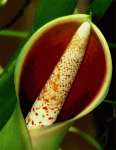
At 11:59AM the spathe had rotated around 20 degrees to the left. No female flowers appear evident but the pheromone has begun to return as has theromgenic heat. The scent has changed and the mint is no longer apparent. All that is noticed now is a musky smell. Both my wife and oldest daughter could easily detect both. The heat can be felt with your hand in front of the spathe without touching anything.
Steve Lucas
| +More |
www.ExoticRainforest.com
-------------- next part --------------
An HTML attachment was scrubbed...
URL: http://www.gizmoworks.com/mailman/private/aroid-l/attachments/20080607/82cd73e2/attachment-0001.htm
-------------- next part --------------
A non-text attachment was scrubbed...
Name: Phil-Sagg-anthesis-11-50-AM.gif
Type: image/gif
Size: 186444 bytes
Desc: not available
Url : http://www.gizmoworks.com/mailman/private/aroid-l/attachments/20080607/82cd73e2/attachment-0001.gif
|
|
From: Steve at ExoticRainforest.com (ExoticRainforest) on 2008.06.07 at 23:44:25(17794)
Not tasty!
>The red dots were not there this afternoon, but are clearly visible
>now. I have no idea what these are!
they look like some kinda goopy leaking out. have you tried tasting it?
hermine
| +More |
-------------- next part --------------
An HTML attachment was scrubbed...
URL: http://www.gizmoworks.com/mailman/private/aroid-l/attachments/20080607/b2848f1e/attachment-0001.htm
|
|
From: Steve at ExoticRainforest.com (ExoticRainforest) on 2008.06.07 at 23:50:34(17795)
Thanks Julius. I'll take time to read it after I get some rest. I was up all night and have been watching this thing all day. So far, only an hour or so sleep in the past 40 hours. Did you read Tom's post about it being to apply a "sticky" substance to the beetle?
Steve
| +More | |
Dear Steve,
Once more I`ll tout Deni Bown`s fantastic book whice we all should own and read!---"Aroids, plants of the Arum Family".
She fully explains the purpose of this resin which is produced on the spadix, and seems unique to the genus Philodendron. She report on this resin on pg. 215, and goes on lower down on the page to discuss the nectaries which occur on many aroids on the surface of the spathe, or on the peduncles, bases of some species leaves, etc. and, as Dr. Croat explained, act as ant attractants when they produce a sweet liquid. I have observed this on Urospatha, as in Florida we have a very small red ant which is slow and almost invisible, but which stings like hell, and can really spoil your day. They used to LOVE this nectar produced by these very special glands on my Urospathas, and I have been stung by them many times when I did not take note of their presence on a bloom!
As a side note concerning these nectaries which also occur on many other genera of plants, and to illustrate one of the MANY things which I have observed over the years (too many years!) which have kept my interest (no, my obsession) with nature at the level it has been throughout my life, I offer the following story--
On my very first day in the Ecuadorian Amazon rain forest, I admit that I was somewhat ''underwhelmed'', as I was born and raised in Trinidad, W.I., and on seeing this zone in E. Ecuador, I commented to the Ecuadorian oilfield engineer I was working with that were it not for the different species of Cecropia trees around us, I would think I was in the Morouga or Rio Claro roads back "home'' in Trinidad! My mention of Cecropia trees keyed him to the fact that I knew something about Botany, and he confessed to me that he too was a plant ''nut'', and he warned that we must be careful NOT to let that info. out, as the Company was NOT friendly toward ''tree huggers''!
He then asked me if I had ever heard ants ''talk''---I replied-- ''right!! talking ants--what`s next, flying monkeys??" He walked my smart- commenting self over to a barbed wire fence on the side of the dirt road, the posts of which were ''living fence posts'' made by sticking fresh-cut limbs of a Eurithrina (spelling?) sp. tree into the soil, where they lived and grew, with the barbed wire nailed into them. Their canopy tops were kept trimmed into an attractive ball (dead wooden posts were QUICKLY consumed by termites!!). He then VERY carefully showed me that some HUGE ants, +1 ", were on the limbs and petioles of the leaves on these ''fence posts'', these ants were the dreaded and feared ''congas'' (also called ''una bala'' or ''one bullet'' ants in Cen. America), the largest Ponerine stinging ant in S. and Central America. I was certainly impressed at my very first sighting of these most impressive insects, and asked Mario --"and you say that these ants ''talk"? He instructed me to place my
head and ear close to (but not TOO close!) any ant. Low and behold, I then heard the beautiful (to me!) sounds of tiny squeaks and twerps, like one would expect from tiny birds or rodents, but NOT from ants!
To come back to nectaries, I was then able to show Mario that these huge ants were activly guarding the foliage of these fence posts against all browsers because of the presence of the large nectaries which we saw at the base of every leaf, and we could see the ants collecting and feeding on liquid being produced within the tiny ''cups'' of these organs! Knowing of the usually carnivorous diet of these ants (we have a smaller species on Trinidad), he and I began to catch grass hoppers, and offered them to individual ants on the tip of a LONG palm spine.
These large insects were eargarly accepted by the ant, and a quick sting killed the grasshopper, which was quickly dismembered by several ants, and the parts carried down the tree/post and into the below-ground nest of these dangerous but oh-so-interesting ants.
So-- Yes, Virginia, there ARE talking ants!
Thanks for your indulgence.
Julius
> Steve: I commented on the dots before seeing the pictures. I thought you were talking about he dots on the petioles. The dots on the spadix are from an accumulation of resin. The resin gets on the beetles and makes them sticky so that when they leave they can carry away the pollen which otherwise won?t stick to their bodies.
>
> Tom
-------------- next part --------------
An HTML attachment was scrubbed...
URL: http://www.gizmoworks.com/mailman/private/aroid-l/attachments/20080607/7259ae8a/attachment-0001.htm
|
|
From: Steve at ExoticRainforest.com (ExoticRainforest) on 2008.06.08 at 00:13:59(17797)
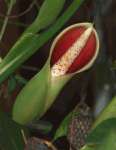
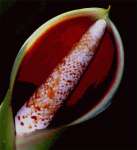
Here's the latest images.
These were taken at 6:30PM on Saturday. The spathe has now rotated to a 45 degree angle on the axil. It also appears to be slightly closing. I have read in some material the spathe actually closes around the beetles and they do the work of pollination inside the closed tube. If this is the case with this species, I have no idea since I'm simply observing. Anyone with more knowledge is welcome to fill in the blanks.
The pheromone is now only slight and no thermogenic heat can be felt on the hand. The scent is of a slight musk combined with a small amount of mint. I'm going to try for one more set around 10:00PM but I've been up for nearly 38 hours trying to capture this. Hopefully I'll get another good set. No female flowers can be observed as far as I can tell.
Steve
| +More |
-------------- next part --------------
An HTML attachment was scrubbed...
URL: http://www.gizmoworks.com/mailman/private/aroid-l/attachments/20080607/6ed61837/attachment-0001.htm
-------------- next part --------------
A non-text attachment was scrubbed...
Name: spathe-45-degree-angle-3.gif
Type: image/gif
Size: 178867 bytes
Desc: not available
Url : http://www.gizmoworks.com/mailman/private/aroid-l/attachments/20080607/6ed61837/attachment-0002.gif
-------------- next part --------------
A non-text attachment was scrubbed...
Name: spathe-45-degree-angle-tigh.gif
Type: image/gif
Size: 144834 bytes
Desc: not available
Url : http://www.gizmoworks.com/mailman/private/aroid-l/attachments/20080607/6ed61837/attachment-0003.gif
|
|
From: growit7 at windstream.net (Tere Baber) on 2008.06.08 at 01:11:04(17798)
I LOVE that red hood!!
----- Original Message -----
From: ExoticRainforest
| +More |
To: Discussion of aroids
Sent: Saturday, June 07, 2008 12:18 PM
Subject: [Aroid-l] Philodendron sagittifolium at female anthesis!
At 11:59AM the spathe had rotated around 20 degrees to the left. No female flowers appear evident but the pheromone has begun to return as has theromgenic heat. The scent has changed and the mint is no longer apparent. All that is noticed now is a musky smell. Both my wife and oldest daughter could easily detect both. The heat can be felt with your hand in front of the spathe without touching anything.
Steve Lucas
www.ExoticRainforest.com
------------------------------------------------------------------------------
_______________________________________________
Aroid-L mailing list
Aroid-L at www.gizmoworks.com
http://www.gizmoworks.com/mailman/listinfo/aroid-l
------------------------------------------------------------------------------
No virus found in this incoming message.
Checked by AVG.
Version: 7.5.524 / Virus Database: 269.24.6/1485 - Release Date: 6/5/2008 10:07 AM
-------------- next part --------------
An HTML attachment was scrubbed...
URL: http://www.gizmoworks.com/mailman/private/aroid-l/attachments/20080607/b4267ee6/attachment-0001.htm
|
|
From: Steve at ExoticRainforest.com (ExoticRainforest) on 2008.06.08 at 03:00:00(17802)
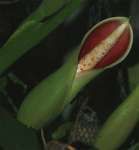
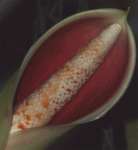
9:30PM Saturday night. Last ones tonight unless I wake up in the middle of the night!
Does anyone see what I see happening to the color red? It appears to be lightening. The rotation continues. The mint smell to the pheromone is stronger while the musk is weaker. No female flowers ever observed. My guess is if beetles were present they would be taking up residence inside for the night. Free warm hotel if you will. I don't know if i'll see female anteses or pollination. The spathe is closing.
Does anyone know if this is a species that closes the tube to capture the beetles and force them to coplulate and pollinate inside the tube? I recently read of that happening. Marc? Tom? Julius?
Steve Lucas
| +More |
www.ExoticRainforest.com
-------------- next part --------------
An HTML attachment was scrubbed...
URL: http://www.gizmoworks.com/mailman/private/aroid-l/attachments/20080607/33e06894/attachment-0001.htm
-------------- next part --------------
A non-text attachment was scrubbed...
Name: spathe-9-30PM-Saturday-rota.gif
Type: image/gif
Size: 220238 bytes
Desc: not available
Url : http://www.gizmoworks.com/mailman/private/aroid-l/attachments/20080607/33e06894/attachment-0002.gif
-------------- next part --------------
A non-text attachment was scrubbed...
Name: spathetigh3--9-30pm-Sat.gif
Type: image/gif
Size: 273566 bytes
Desc: not available
Url : http://www.gizmoworks.com/mailman/private/aroid-l/attachments/20080607/33e06894/attachment-0003.gif
|
|
From: Steve at ExoticRainforest.com (ExoticRainforest) on 2008.06.08 at 07:19:43(17804)
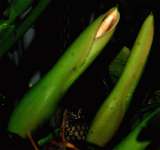
At 2:00AM Sunday morning the event is almost visually complete. The spathe is again almost closed. The lower spathe has yet to open. The red enterior has faded to a dull orange and no female or male flowers were ever observed. It would appear this species closes around the beetles while they are mating inside and pollination occurs within the spathe tube.
Anyone who cares to offer a more complete explanation is welcome to do so. I obviously do not fully understand what I have observed but would love to understand more.
And that appears to be it for the photos of this event which lasted two days!
Steve Lucas
| +More |
www.ExoticRainforest.com
-------------- next part --------------
An HTML attachment was scrubbed...
URL: http://www.gizmoworks.com/mailman/private/aroid-l/attachments/20080608/6ab63e3b/attachment-0001.htm
-------------- next part --------------
A non-text attachment was scrubbed...
Name: spathe-event-complete-2-00A.gif
Type: image/gif
Size: 229925 bytes
Desc: not available
Url : http://www.gizmoworks.com/mailman/private/aroid-l/attachments/20080608/6ab63e3b/attachment-0001.gif
|
|
From: Steve at ExoticRainforest.com (ExoticRainforest) on 2008.06.08 at 13:45:00(17806)

Philodendron sagittifolium cut spathe
Julius asked this morning that I cut the spathe away. Here is the photo of the exposed interior. I would like for him to explain what you are seeing. I've read this material several times but do not feel I am proficient or qualified in making an explanation. I intentionally left the photo oversized so you could scroll up and down to better examine the subject.
Take it away Julius!
Steve Lucas
| +More |
www.ExoticRainforest.com
-------------- next part --------------
An HTML attachment was scrubbed...
URL: http://www.gizmoworks.com/mailman/private/aroid-l/attachments/20080608/1d2ed5f7/attachment-0001.htm
-------------- next part --------------
A non-text attachment was scrubbed...
Name: spathe-cut-final-small.gif
Type: image/gif
Size: 99234 bytes
Desc: not available
Url : http://www.gizmoworks.com/mailman/private/aroid-l/attachments/20080608/1d2ed5f7/attachment-0001.gif
|
|
From: ju-bo at msn.com (ju-bo at msn.com) on 2008.06.08 at 17:38:01(17808)
________________________________
> From: Steve at ExoticRainforest.com
> To: aroid-l at gizmoworks.com
> Date: Sat, 7 Jun 2008 22:00:00 -0500
> Subject: [Aroid-l] Philodendron sagittifolium at female anthesis!
>
> 9:30PM Saturday night. Last ones tonight unless I wake up in the middle of the night!
Dear Steve and aroid friends,
The blooming/anthesis cycle of this species lasts 2 days. The lower portion (the tube) of the spathe never opens in this species, probably in the entire genus.
I don`t believe that this spathe could trap the Scrab beetle pollinators even if it wanted to, as they are strong animals. I once collected about a dozen of them from a bloom in the jungle of E. Ecuador, and was unable to ''hold on'' to them for long as they would burrow (painfully, I may add!) between my fingers and out of my tightly closed fist.
You could take notes and observe if the constriction around the spadix opens, then closes and then opens again when the next bloom goes through its cycle, measurements taken at the ''waist'' and visual observations would tell you if this is happening.
Read pg. 59 of Deni`s book, she details a lot about this event there.
I don`t believe the beetles need to be ''trapped'' by this closing, they could and would escape at any time IF they wanted to, but why would they?? Warmth, food (I forgot to detail that they will eat the sterile flowers as a snack) and lots of parterners and sex in a secure ''room'' are being provided, so why would even want to leave?? Perhaps the closing of the spathe at the constriction may retain the heat in the lower portion of the spathe (the tube) for the beetles. When the warmth stops at the end of the cycle, and the food is used up, they just crawl out, picking up pollen on their now resin-covered legs and bodies, and fly off to the next available and ''ready'' bloom.
By the way, I believe that some stingless bees collect this resin and use it in the construction of their combs/cells, and in waterproofing of their nests. Native Indians in South America collect it from their nests and use it to make their blow-guns both air and watertight.
Good Growing,
Julius
| +More |
> Does anyone see what I see happening to the color red? It appears to be lightening. The rotation continues. The mint smell to the pheromone is stronger while the musk is weaker. No female flowers ever observed. My guess is if beetles were present they would be taking up residence inside for the night. Free warm hotel if you will. I don't know if i'll see female anteses or pollination. The spathe is closing.
>
> Does anyone know if this is a species that closes the tube to capture the beetles and force them to coplulate and pollinate inside the tube? I recently read of that happening. Marc? Tom? Julius?
>
> Steve Lucas
> www.ExoticRainforest.com
|
|
From: donbit121 at hotmail.com (Don Bittel) on 2008.06.10 at 03:07:05(17822)
Steve,
Did you see any white pollen on the male portion on the second or third night of flowering?
Don
| +More | |
From: Steve at ExoticRainforest.comTo: aroid-l at gizmoworks.comDate: Sun, 8 Jun 2008 08:45:00 -0500Subject: [Aroid-l] : Philodendron sagittifolium at female anthesis!
Philodendron sagittifolium cut spathe
Julius asked this morning that I cut the spathe away. Here is the photo of the exposed interior. I would like for him to explain what you are seeing. I've read this material several times but do not feel I am proficient or qualified in making an explanation. I intentionally left the photo oversized so you could scroll up and down to better examine the subject.
Take it away Julius!
Steve Lucas
www.ExoticRainforest.com
_________________________________________________________________
It?s easy to add contacts from Facebook and other social sites through Windows Live? Messenger. Learn how.
https://www.invite2messenger.net/im/?source=TXT_EML_WLH_LearnHow
-------------- next part --------------
An HTML attachment was scrubbed...
URL: http://www.gizmoworks.com/mailman/private/aroid-l/attachments/20080609/2e62d5f8/attachment.htm
|
|
From: Steve at ExoticRainforest.com (ExoticRainforest) on 2008.06.10 at 11:05:23(17825)
Unfortunately no. I had been asked to observe for it on each evening but never actually see it or find it in any of the 300 photos I took. I have another spathe opening now and will try again, although my body physically won't allow me to do another 36 hour stint. That effort took a toll on me but was worth if for the learning experience. If I get lucky and can photograph the pollen strings I'll certainly add them to the new webpage.
Steve
| +More | |
Did you see any white pollen on the male portion on the second or third night of flowering?
Don
-------------- next part --------------
An HTML attachment was scrubbed...
URL: http://www.gizmoworks.com/mailman/private/aroid-l/attachments/20080610/713efb85/attachment-0001.htm
|
| |
Note: this is a very old post, so no reply function is available.
|
|















